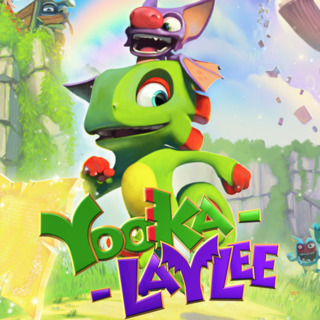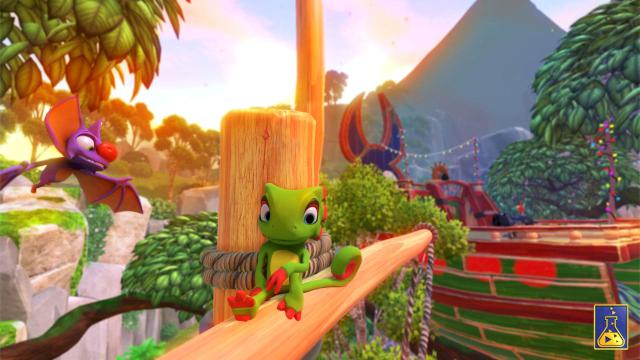
Yooka-Laylee was a surprise hit on Kickstarter. Out of nowhere seemingly came this blast from the past and it captured the hearts of many. Yooka-Laylee makes no excuses – it’s more than a love-letter to the classic Nintendo 64 3D platform collect-em-ups. It could well be considered a sequel to the Banjo-Kazooie games, which is both a positive, and also a slight shortfall.
A challenge which Yooka-Laylee faces immediately is the comparison to the Banjo games. If you swapped Yooka for Banjo, and Laylee for Kazooie you’d be forgiven for thinking this was Banjo-Threeie. In fact, it essentially is. Whereas Banjo and Kazooie came to develop this relationship between them and their own character traits, they need to be established from the start here and it’s never really clear what makes each of these characters tick. They both crack wise at each other, and other characters in the game world and I did struggle for some time to consistently recall which was which. Ultimately it probably doesn’t matter. These games have always been about the core Nintendo gameplay values. It must be suitable for all, easy to pick up and play but challenging in equal measure, with exciting areas to explore. It ticks all of those boxes.
Much like classic Nintendo games, Yooka-Laylee eases you in. You start in a hub world where you learn the basics and have to collect a few bits before you can progress into another hub world. The plot is thin but doesn’t matter – a book has been stolen and you’re to collect all the pages to recover the book. This sets the tone and thematics for the collectibles and they exist ultimately to further your progression to the next world to collect more.
The most common of which are Quills, feathers essentially which act as a currency for powering up your moves and learning more. Pagies are your premium collectible which are a currency for opening other worlds, and there are other bits to find – Jinjos from Banjo are here as ‘Ghost Writers’ to be found in each world, as well as items which let you transform to be able to interact with the environment in different ways.

Unlike some of Rare’s N64 games, it just about strikes a balance between being confusing, overwhelming or obvious. There’s a nice mixture of exploration and reward, whilst not being too obvious but rewards the daring. Can you make that jump to that platform? You might think not, but try it and make it, and there is surely a reward for your efforts.
The worlds look fantastic – bright and colourful and busting full of excitement. They do suffer a bit with draw distance on items (is it worth going over there? Looks like not but as you get closer you can see objects appear) but otherwise each world feels very large and has a lot of exploration to offer. The first world – set in a green, pleasing environment has old temples, floating platforms and water areas to explore, complimented by delightful music which should be annoying but never becomes it, and adds to the experience. It’s amazing how you can find new areas when you’re convinced you’ve seen it all, and having thought I’d seen everything in the first area, I still had another 15 pagies to hunt down!
The pagies are often found behind interesting puzzles. It can be as simple as collect a number of additional items to free them, or do a challenge from another character, or even just found in a hard to reach spot. Once you have enough, rather than simply unlock the next world (which you may not be able to from the hub world if you are lacking the abilities), you can expand the current one, revealing even more to explore. This adds some good player choice although I discovered you’re often better to open up more worlds rather than fish through one.
The more worlds you open, the more opportunity you have for moves. Delivered by the curiously named Trowzer Snake (?!) moves are free in the hub world but come at a cost in the game worlds. These can be as simple as a jump smash, or move advanced like Laylee’s sonar detection to reveal alternative paths and puzzles. There are some nice additions here – for example, Yooka can eat butterflies for health or collect them for energy (to perform moves). She can also eat plants which give new effects, such as spit ice or breathe fire.
The more I play, the more I could not shake the similarities to the Banjo series. Obviously, a number of the team worked on those games so it is to be expected, but from the formula of the collectibles, the dialogue from characters, even down to the in game font – it is very, very similar. It’s more of an enhanced version of those games than a progression, aside from the benefits by more horsepower under the current generation of consoles.
This may or may not be a deal breaker depending on how much you loved (or miss) those sorts of games. However it also brings back a couple of things which I hadn’t missed – difficulty in judging jumps in 3D platformers and camera issues. These are inevitably linked, but the camera is my biggest gripe in Yooka-Laylee. I can’t decide if it is just plain bad or if to assist less familiar gamers that it adds some ‘assist’ to the positioning but I often found myself wrestling with it to get it in the right position for what I wanted to do, or have it veering in odd directions. One particularly frustrating part was where the camera moves to almost a 2D platform section, but Yooka still moves in a 3D realm. So I’d find myself adjusting toward or away from the camera in order to jump straight. More than once I’d miss critical jumps and have to do some backtracking which shakes the nostalgic glow to more of a scream over “haven’t games moved on?”.
Nonetheless, Yooka-Laylee is a blast. It’s great fun to play something so similar to years gone by, but with worlds with feel like that could have years ago where the hardware would restrict the imagination of the developers. Hopefully a patch can sort out the camera issues and turn this into an essential purchase.
Reviewed on PS4


Leave a Reply